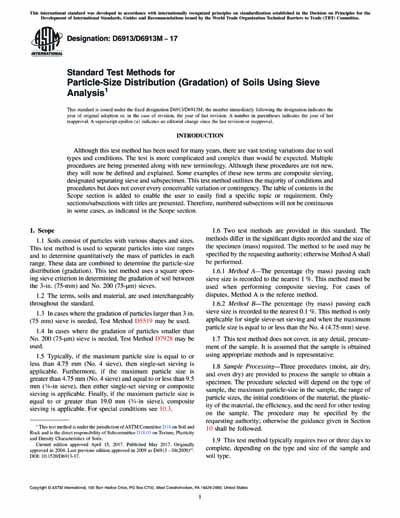Most recent
ASTM D6913/D6913M-17
Standard Test Methods for Particle-Size Distribution (Gradation) of Soils Using Sieve Analysis
1.1 Soils consist of particles with various shapes and sizes. This test method is used to separate particles into size ranges and to determine quantitatively the mass of particles in each range. These data are combined to determine the particle-size distribution (gradation). This test method uses a square opening sieve criterion in determining the gradation of soil between the 3-in. (75-mm) and No. 200 (75-µm) sieves.
1.2 The terms, soils and material, are used interchangeably throughout the standard.
1.3 In cases where the gradation of particles larger than 3 in. (75 mm) sieve is needed, Test Method D5519 may be used.
1.4 In cases where the gradation of particles smaller than No. 200 (75-µm) sieve is needed, Test Method D7928 may be used.
1.5 Typically, if the maximum particle size is equal to or less than 4.75 mm (No. 4 sieve), then single-set sieving is applicable. Furthermore, if the maximum particle size is greater than 4.75 mm (No. 4 sieve) and equal to or less than 9.5 mm (3/8-in sieve), then either single-set sieving or composite sieving is applicable. Finally, if the maximum particle size is equal to or greater than 19.0 mm (3/4-in sieve), composite sieving is applicable. For special conditions see 10.3.
1.6 Two test methods are provided in this standard. The methods differ in the significant digits recorded and the size of the specimen (mass) required. The method to be used may be specified by the requesting authority; otherwise Method A shall be performed.
1.6.2 Method B—The percentage (by mass) passing each sieve size is recorded to the nearest 0.1 %. This method is only applicable for single sieve-set sieving and when the maximum particle size is equal to or less than the No. 4 (4.75-mm) sieve.

